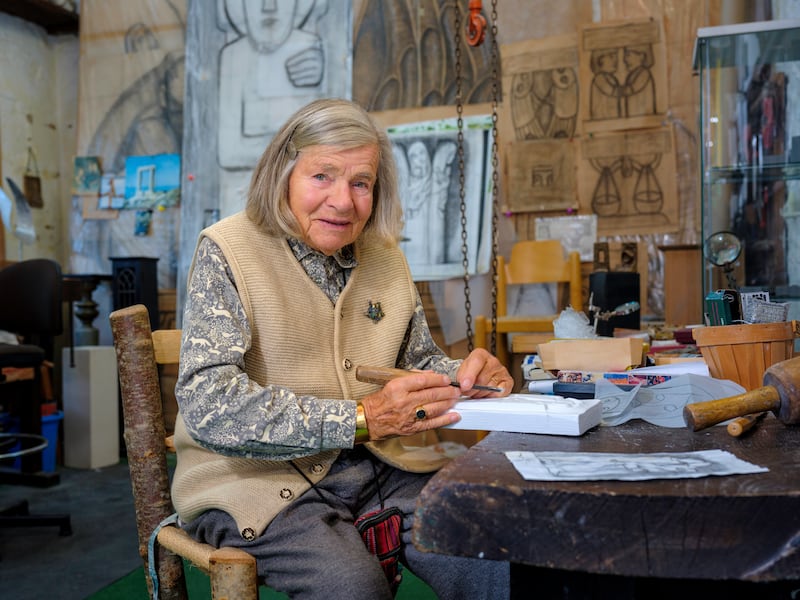Born: May 25th, 1927
Died: March 24th 2024
Imogen Stuart, the Irish-German sculptor who has died aged 96, changed how Irish people viewed their Christian heritage.
Over a remarkable 75 years in Ireland, as European art shifted towards concepts in the head, Stuart produced elegant works that spoke to the heart. To understand her work, watch others enjoy it.
READ MORE
At the opening of her last retrospective in Dublin Castle last November, children couldn’t stay away from Wilhelmina, a large mahogany tortoise on the floor. All evening they climbed on it, stroked it, talked to it. Similarly, Fiddler of Dooney, based on the Yeats poem, has attracted generations of Stillorgan children to join Stuart’s brass children in their joyful dance.
Her best-known church works – stations of the cross, baptismal fonts, altars and angels – have remained a beloved focus of faith and consolation long after the institution that commissioned them has fallen from grace.
[ A life in stone: Sculptor Imogen Stuart reflects on her life and her workOpens in new window ]
As resolute as her namesake in Shakespeare’s Cymbeline, Stuart was a diminutive yet energetic figure. With her trademark grey bob and a large selection of embroidered Chinese jackets and pill hats, she always stood out, her sparkling blue eyes and ripped velvet voice giving her an air of a German Judi Dench.
She was endlessly curious and enthusiastic for beauty she encountered in art, nature and the everyday: a baroque church, a Handel aria, an alpine blossom, Robby the robin who visited her kitchen.
Curiosity for her second homeland is what prompted this Berlin-born Lutheran artist – armed with hammer, chisel and chutzpah – to give Irish Catholicism a radical makeover of expressionist angles and elongated Romanesque features. Her St Kevin, reproduced on a 2018 stamp, has attitude and cheekbones; her sensual 1958 St Brigid has a swan neck and sass.

Whether working on new churches, or remodelling old ones along Vatican II lines, Stuart lobbied bishops to look beyond the safety of catalogue-bought interiors from Italy. Irish Catholicism was different, she argued, so Ireland’s churches should look different.
Though Stuart had champions among cultivated clerics, not all welcomed her enthusiasm and lack of deference.
Inspecting her Galway Cathedral doors in 1965 with disapproval, Bishop Michael Browne listened to Stuart’s patient explanation of her design, then sniffed: “You Germans all have a touch of Hitler about you.”
It was the ultimate insult for someone whose life had been turned upside-down by the Nazis.
Stuart was born in Berlin in 1927, midway between the fall of Kaiser Wilhelm and the rise of Adolf Hitler. She remained “hopelessly sentimental” about her home city.
Her mother, Katharina Kluger; and father, Bruno E Werner; met at university in Munich and moved to Berlin where Werner, a first World War veteran, worked variously as an antique dealer, critic, arts editor and writer. But the 1935 Nuremberg Laws endangered Werner’s Jewish mother, Werner and his family.
Stuart said she and her younger sister Sibylle were shielded from the growing danger – and their Jewish heritage – as Werner went underground. He survived, as did their Bauhaus-designed family home, but their elegant pre-war life was gone.
While Ian remarried, Imogen – independent for the first time in her life – kept working. Her silent studio was her refuge, particularly after her daughter Siobhán was killed in a car crash in 1988
Rather than complete an education already interrupted by war, Werner found his artistic daughter Imogen a training place in Bavaria with Otto Hitzberger, an acclaimed sculptor who had fallen foul of the fascists.
Stuart adored her sculptor master, and his influence is clear on her work, but she soon fell in love with an upstart arrival from Ireland: Ian Stuart. Ignoring Hitzberger’s warnings that he was a “Schlawiner” – a rascal – the 22-year-old followed Ian to Ireland in 1949 and fell in love a second time, with the beauty and mystery of Glendalough’s fern-filled hills. The couple were married in 1951 and lived in genteel poverty in the damp Laragh Castle with Ian’s depressed, chain-smoking mother Iseult Gonne Stuart, supported by Ian’s grandmother, Maud Gonne McBride.
A happy first decade of marriage in Ireland brought three children – Aisling, Aoibheann and Siobhán – and growing success as sculptors. Their second decade, in Sandycove with Ian part of the south Dublin artistic set, was less successful and their marriage, overshadowed by infidelity, ended in 1971.
While Ian remarried, Imogen – independent for the first time in her life – kept working. Her silent studio was her refuge, particularly after her daughter Siobhán was killed in a car crash in 1988.
Behind Stuart’s gentle artistic temperament was a shrewd, iron charm who knew how to cultivate interest, secure commissions and nudge government agencies – even presidents – to bow to her will. Visitors to her Aladdin’s cave of a living room were plied with schnapps from her father’s native Saxony, questioned thoroughly and often given jobs to do.
Her latter years were a search for closure with her German homeland and its betrayal of the interwar golden artistic age that her parents opened to her. Lost forever, Stuart found beauty instead in Ireland and leaves behind a remarkable body of work celebrating our own golden age.









